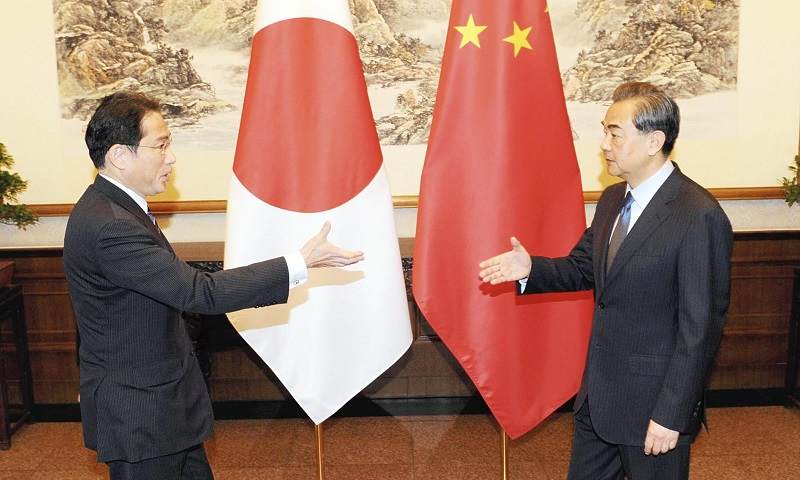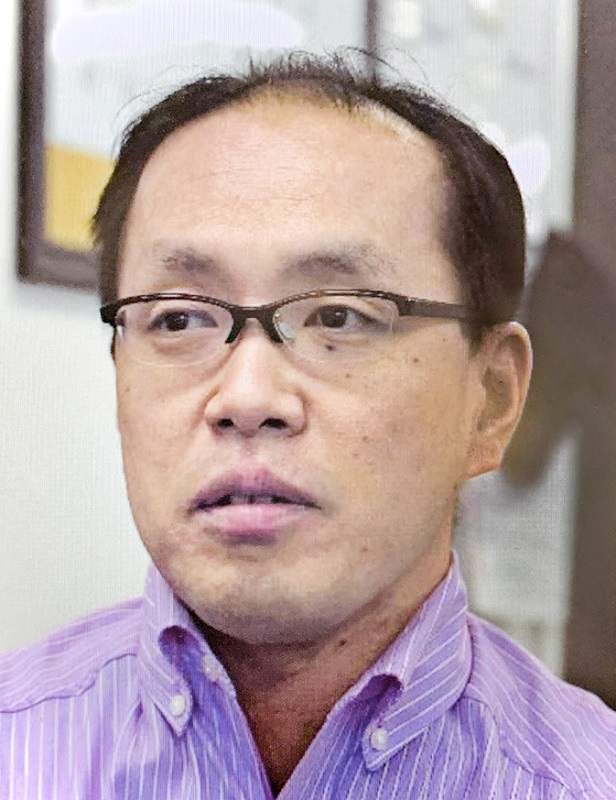Fraught relations with China call for ‘shitataka’ approach by Kishida

Prime Minister Fumio Kishida often met Chinese officials during his time as foreign minister, such as this 2016 meeting with Chinese Foreign Minister Wang Yi in Beijing.
8:00 JST, September 3, 2022
“Shitataka” is a Japanese word with multiple meanings that even Japanese find difficult to explain in simple terms. For example, it can be used in the following way: “She is a quick-witted and shitataka woman.” In this case, “shitataka” has a positive meaning, such as “clever,” “patient” or “a tough negotiator.” But it can also have a slightly negative meaning, such as “calculating” or “cunning.”
On Sept. 29, Japan and China will mark the 50th anniversary of their normalization of diplomatic relations in 1972. Prime Minister Fumio Kishida, who took office last October, often uses the word “shitataka” in describing his approach to dealing with China.
“Perhaps we are in a celebratory mood as we mark the 50th anniversary of the normalization of diplomatic relations, but looking at the current situation, it is important to stabilize Japan-China relations with a sense of urgency. The ‘shitataka’ of Japanese diplomacy is being tested.”
Kishida thus emphasized the importance of “shitataka” diplomacy toward China on a radio program in January. Referring to China’s aggressive maritime expansion and human rights abuses in the Xinjiang Uygur Autonomous Region, he said, “I will say what needs to be said [to China]. I will firmly raise these issues.”
If we interpret Kishida’s “shitataka diplomacy” literally, it means that the Japanese government should be “clever,” “patient” and sometimes “calculating” in its dealings with China. However, this is easier said than done.
The relationship between Japan and China has gone through dramatic changes over the past half century.
When Kakuei Tanaka became prime minister in July 1972, he appointed his ally Masayoshi Ohira as foreign minister and immediately began negotiations for the normalization of diplomatic relations between Japan and China. The “Nixon Shock” of July 1971, when U.S. President Richard Nixon announced in a televised speech that he would visit China, had quickly intensified the trend toward normalization of diplomatic relations with China within Japan.
The Chinese side was also in a hurry to normalize relations due to its intensifying conflict with the Soviet Union and the need for Japanese economic support for its reform and open-door policies. Tanaka visited Beijing about two months after assuming office. He reached a conclusion on the establishment of diplomatic relations with China and broke with Taiwan.
For a long time thereafter, Japan-China relations enjoyed a period of friendship and exchange. One reason for this is that Japan supported China’s economic development. The total amount of Japanese official development assistance (ODA) to China, which began after the normalization of diplomatic relations, amounted to more than ¥3.6 trillion (about $26 billion) over 40 years until all projects ended in fiscal 2021. The money was used to build roads, bridges, ports and other infrastructure in China.
China achieved rapid economic growth and surpassed Japan in nominal gross domestic product in 2010, taking over Japan’s position as the world’s second-largest economy.
Not only has China’s military power been growing, but it has also reached the world’s top level of technological capability in fields such as information technology and artificial intelligence. China is now said to be the sole rival of the United States.
Looking at China’s progress over the past several decades, it can be said that China is the one that has been increasing its national power in a “shitataka” way. Even today, as the world’s second-largest economy, China is not willing to give up its status as a developing country, as evidenced by its leadership of the G77, a group of developing countries at the United Nations. This group has grown from 77 countries at its inception to 134 countries today.
Over the past decade, China has sent vessels into waters around Japan’s Senkaku Islands in a campaign to gradually normalize its navigation there. Currently, Chinese vessels are harassing Japanese fishing boats approaching the Senkaku Islands. It is believed that these moves by China are aimed at bolstering its claim that it has territorial rights to the Senkaku Islands and making that claim a fait accompli.
Japan has repeatedly protested China’s maritime expansion in the East and South China Seas and persistently appealed for law and order. Patience is one of the strengths of the Japanese people, but in this territorial dispute is it possible for Japan to face China in a “calculating” and “cunning” manner? As a country that values democracy and law and order, it is difficult for Japan to ignore international order and rules.
Kishida is from the Kochikai, a traditional LDP faction once headed by Ohira, whom Kishida respects. Not only was Ohira named Tanaka’s foreign minister, but he later served as prime minister himself until his death in 1980, at a time when normalized diplomatic relations between Japan and China were still new.
The Kochikai faction was founded by Hayato Ikeda, who served as prime minister in the early 1960s. Ikeda advocated “Sino-Japanese friendship” and promoted Sino-Japanese trade. Historically, then, Kishida’s faction has been pro-China.
“I don’t like to be called a follower of China,” Kishida told a meeting of Kochikai members last December. Shortly before that, he appointed faction member Yoshimasa Hayashi as foreign minister. Hayashi had served as chairman of the Japan-China Parliamentary Friendship Association. Conservative members of the Liberal Democratic Party complained about Hayashi’s appointment, saying that he was too close to China.
The Japanese government wanted to improve Japan-China relations and make them more stable in preparation for the 50th anniversary of the normalization of diplomatic relations in September. According to government officials, the government envisioned a three-stage arrangement. The first stage was to have been a meeting between the Japanese and Chinese foreign ministers in Cambodia on Aug. 4. The second stage was a meeting between National Security Bureau Director Takeo Akiba and top Chinese diplomat Yang Jiechi, a member of the Politburo of the Communist Party of China. The Japanese government hoped that these two stages would lead to communication between the leaders, such as a telephone conference or online-style meeting, around the Sept. 29 anniversary.
The foreign ministers meeting, called for by the Japanese government, was abruptly canceled by the Chinese side about two hours before it was scheduled to start, in reaction to a visit to Taiwan by U.S. Speaker of the House Nancy Pelosi. The Aug. 4 meeting between Akiba and Yang, however, lasted seven hours, and a wide range of topics were discussed. Details of the meeting have not been disclosed, but it is said to have served as a “place for a fresh start” in Japan-China relations. On Aug. 22, Chinese President Xi Jinping sent a telegram message of sympathy to Kishida, who was infected with the novel coronavirus. It was taken as a positive sign from Xi in preparation for the summit meeting.
It is believed that the Chinese side also wants to stabilize relations with Japan amid the deepening U.S.-China confrontation over the situation in Taiwan. Xi, seeking a third term at the party congress in the fall, likely feels a pressing need to demonstrate stability at home and abroad.
Several foreign leaders are scheduled to be invited to Tokyo for former Prime Minister Shinzo Abe’s state funeral on Sept. 27. It is expected that there will be opportunities for dialogue with Chinese officials on that occasion as well. Kishida will have the difficult task of “saying what needs to be said” to China, while at the same time trying to stabilize Japan-China relations. The true value of Kishida’s “shitataka” diplomacy toward China will soon be tested.
Political Pulse appears every Saturday.

Junya Hashimoto
Hashimoto is a deputy editor in the Political News Department of The Yomiuri Shimbun.




